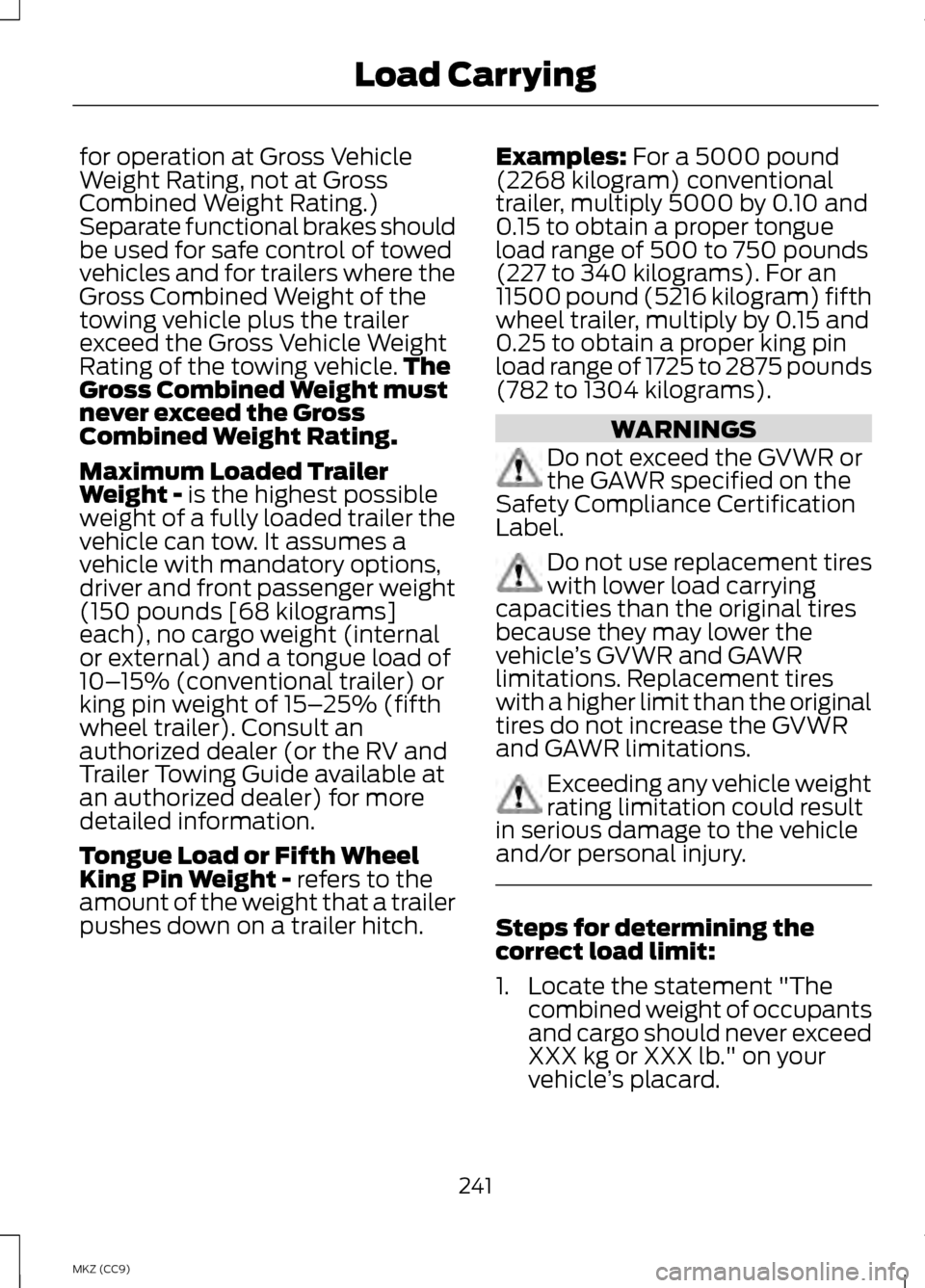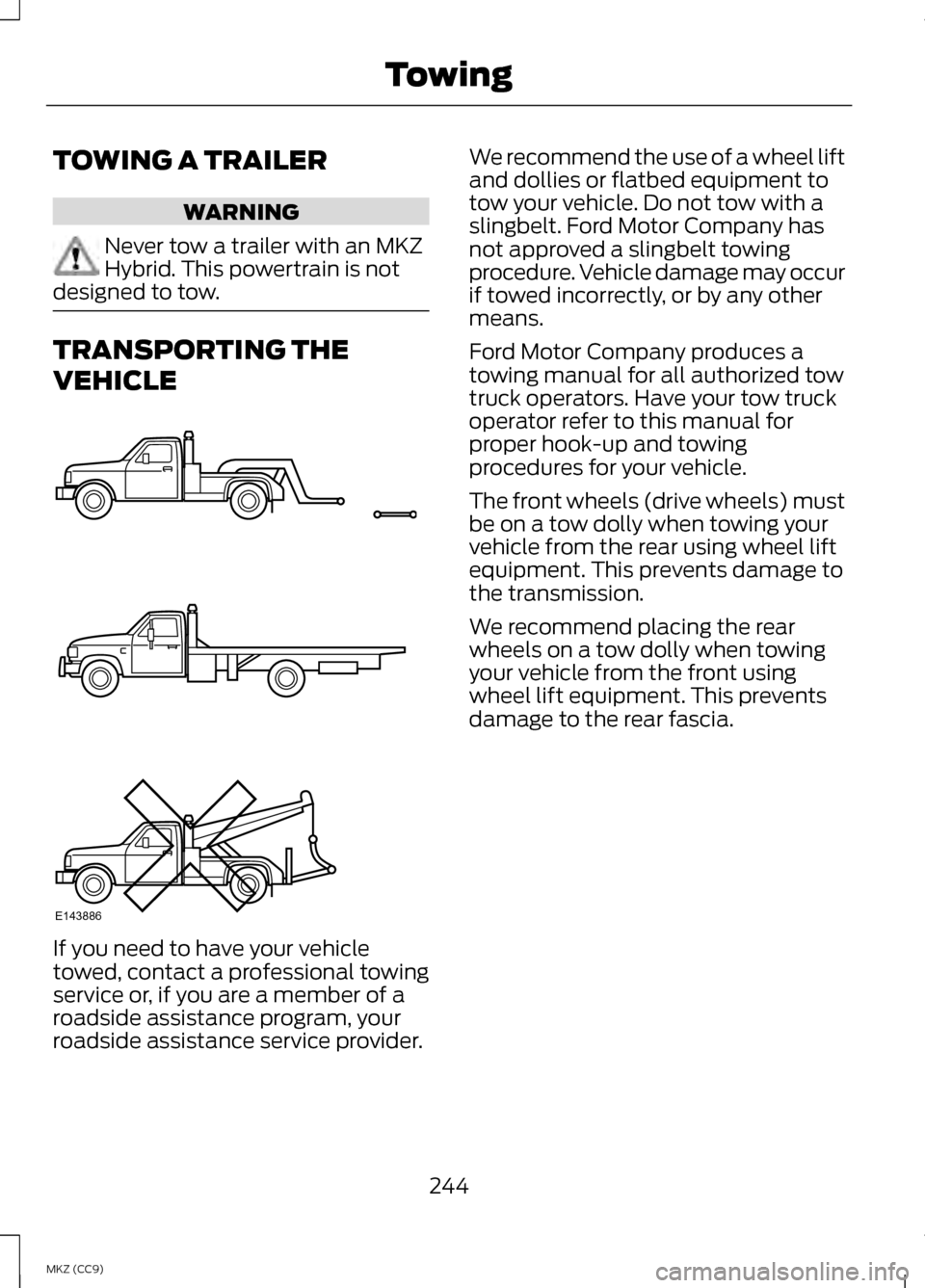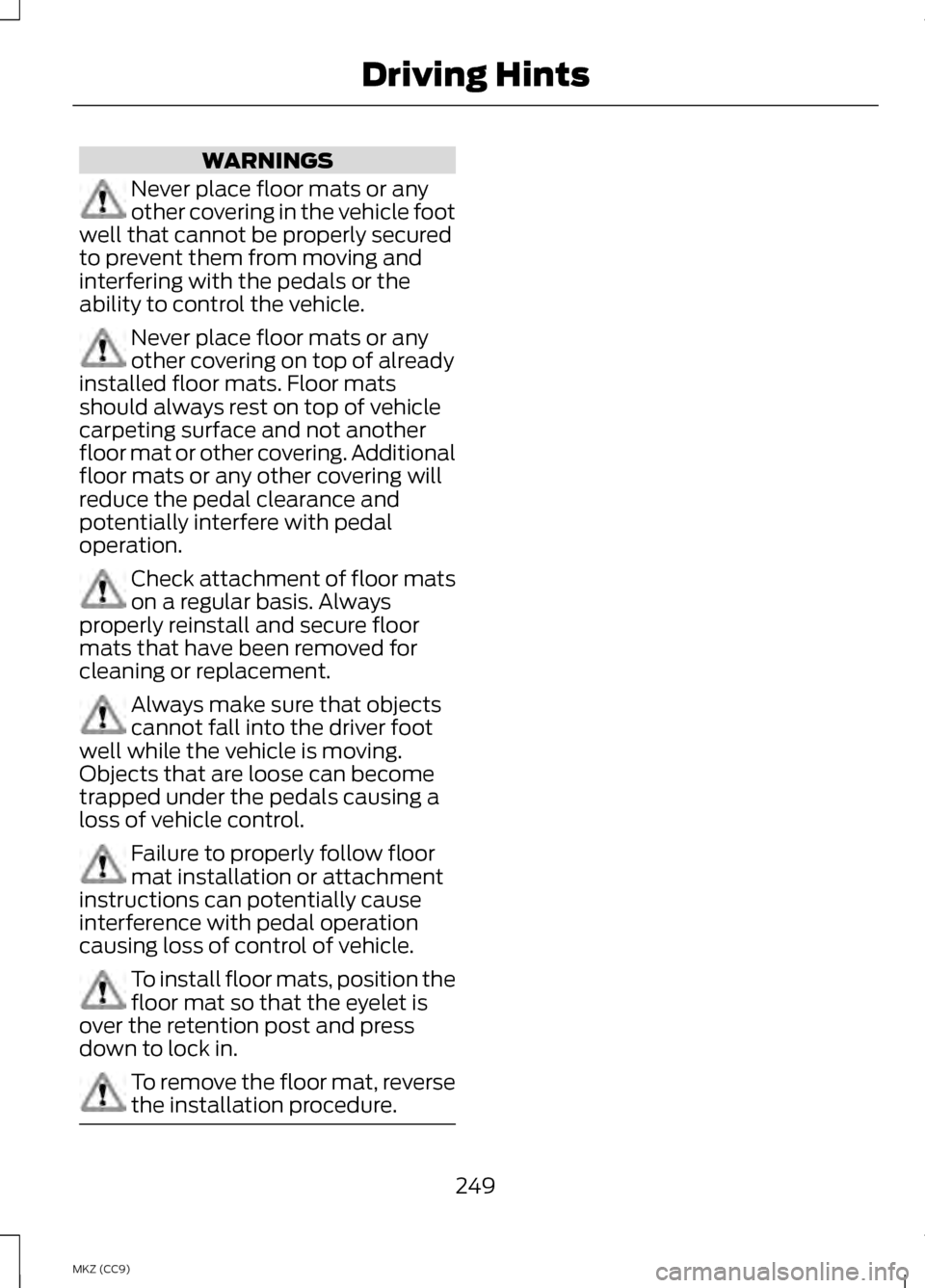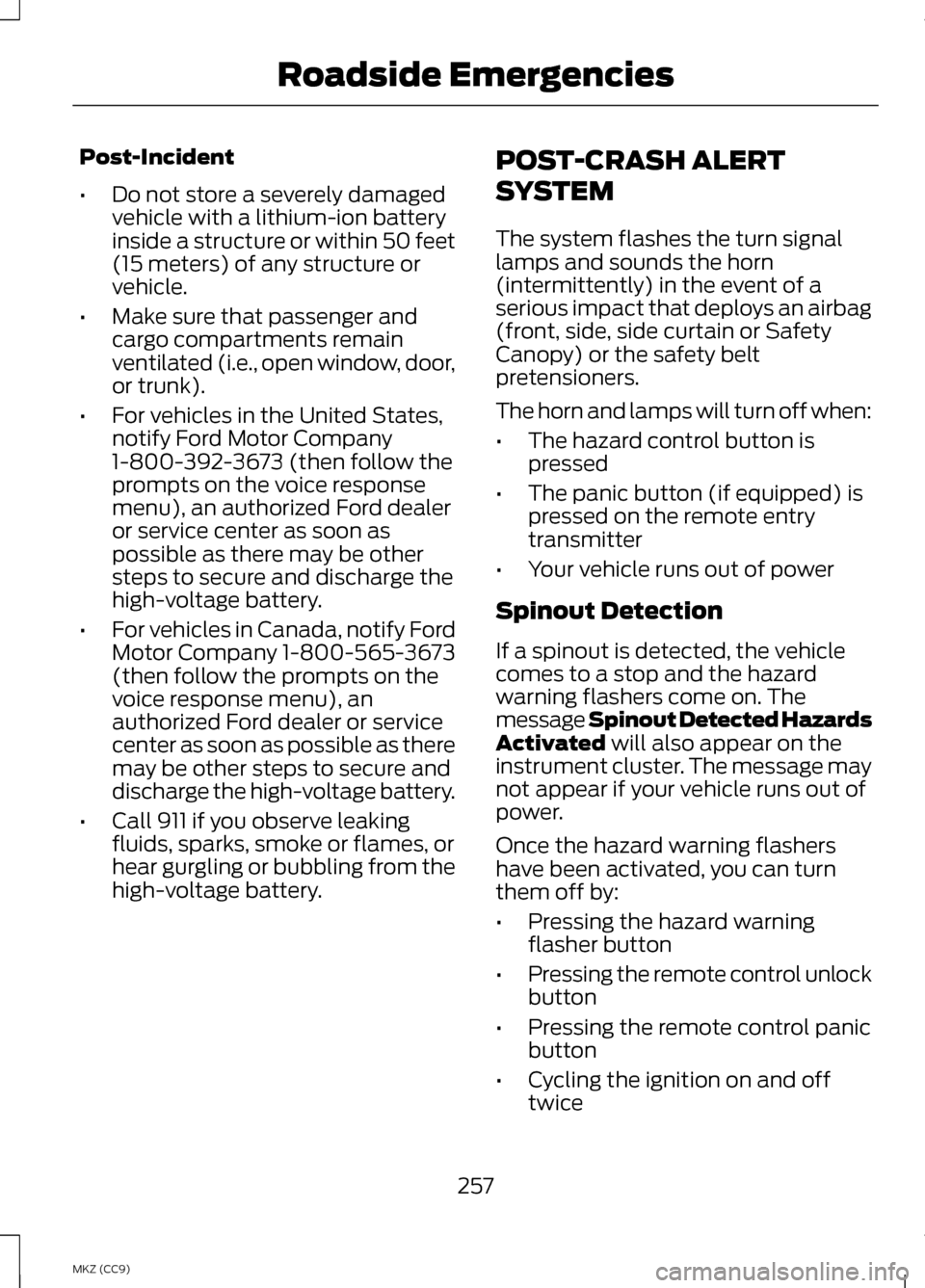Page 243 of 475

for operation at Gross Vehicle
Weight Rating, not at Gross
Combined Weight Rating.)
Separate functional brakes should
be used for safe control of towed
vehicles and for trailers where the
Gross Combined Weight of the
towing vehicle plus the trailer
exceed the Gross Vehicle Weight
Rating of the towing vehicle.
The
Gross Combined Weight must
never exceed the Gross
Combined Weight Rating.
Maximum Loaded Trailer
Weight - is the highest possible
weight of a fully loaded trailer the
vehicle can tow. It assumes a
vehicle with mandatory options,
driver and front passenger weight
(150 pounds [68 kilograms]
each), no cargo weight (internal
or external) and a tongue load of
10– 15% (conventional trailer) or
king pin weight of 15– 25% (fifth
wheel trailer). Consult an
authorized dealer (or the RV and
Trailer Towing Guide available at
an authorized dealer) for more
detailed information.
Tongue Load or Fifth Wheel
King Pin Weight -
refers to the
amount of the weight that a trailer
pushes down on a trailer hitch. Examples:
For a 5000 pound
(2268 kilogram) conventional
trailer, multiply 5000 by 0.10 and
0.15 to obtain a proper tongue
load range of 500 to 750 pounds
(227 to 340 kilograms). For an
11500 pound (5216 kilogram) fifth
wheel trailer, multiply by 0.15 and
0.25 to obtain a proper king pin
load range of 1725 to 2875 pounds
(782 to 1304 kilograms). WARNINGS
Do not exceed the GVWR or
the GAWR specified on the
Safety Compliance Certification
Label. Do not use replacement tires
with lower load carrying
capacities than the original tires
because they may lower the
vehicle ’s GVWR and GAWR
limitations. Replacement tires
with a higher limit than the original
tires do not increase the GVWR
and GAWR limitations. Exceeding any vehicle weight
rating limitation could result
in serious damage to the vehicle
and/or personal injury. Steps for determining the
correct load limit:
1. Locate the statement "The
combined weight of occupants
and cargo should never exceed
XXX kg or XXX lb." on your
vehicle ’s placard.
241
MKZ (CC9) Load Carrying
Page 246 of 475

TOWING A TRAILER
WARNING
Never tow a trailer with an MKZ
Hybrid. This powertrain is not
designed to tow. TRANSPORTING THE
VEHICLE
If you need to have your vehicle
towed, contact a professional towing
service or, if you are a member of a
roadside assistance program, your
roadside assistance service provider. We recommend the use of a wheel lift
and dollies or flatbed equipment to
tow your vehicle. Do not tow with a
slingbelt. Ford Motor Company has
not approved a slingbelt towing
procedure. Vehicle damage may occur
if towed incorrectly, or by any other
means.
Ford Motor Company produces a
towing manual for all authorized tow
truck operators. Have your tow truck
operator refer to this manual for
proper hook-up and towing
procedures for your vehicle.
The front wheels (drive wheels) must
be on a tow dolly when towing your
vehicle from the rear using wheel lift
equipment. This prevents damage to
the transmission.
We recommend placing the rear
wheels on a tow dolly when towing
your vehicle from the front using
wheel lift equipment. This prevents
damage to the rear fascia.
244
MKZ (CC9) TowingE143886
Page 250 of 475

If driving through deep or standing
water is unavoidable, proceed very
slowly. Never drive through water that
is higher than the bottom of the wheel
rims (for cars) or the bottom of the
hubs (for trucks).
When driving through water, traction
or brake capability may be limited.
Also, water may enter your engine
’s
air intake and severely damage your
engine or your vehicle may stall.
Once through the water, always dry
the brakes by moving your vehicle
slowly while applying light pressure
on the brake pedal. Wet brakes do not
stop the vehicle as quickly as dry
brakes. FLOOR MATS WARNINGS
Always use floor mats that are
designed to fit the foot well of
your vehicle. Only use floor mats that
leave the pedal area unobstructed.
Only use floor mats that are firmly
secured to retention posts so that
they cannot slip out of position and
interfere with the pedals or impair safe
operation of your vehicle in other
ways. Pedals that cannot move freely
can cause loss of vehicle control
and increase the risk of serious
personal injury. Always make sure that the floor
mats are properly attached to
the retention posts in the carpet that
are supplied with your vehicle. Floor
mats must be properly secured to
both retention posts to ensure mats
do not shift out of position.
248
MKZ (CC9) Driving HintsE142667 E142666
Page 251 of 475

WARNINGS
Never place floor mats or any
other covering in the vehicle foot
well that cannot be properly secured
to prevent them from moving and
interfering with the pedals or the
ability to control the vehicle. Never place floor mats or any
other covering on top of already
installed floor mats. Floor mats
should always rest on top of vehicle
carpeting surface and not another
floor mat or other covering. Additional
floor mats or any other covering will
reduce the pedal clearance and
potentially interfere with pedal
operation. Check attachment of floor mats
on a regular basis. Always
properly reinstall and secure floor
mats that have been removed for
cleaning or replacement. Always make sure that objects
cannot fall into the driver foot
well while the vehicle is moving.
Objects that are loose can become
trapped under the pedals causing a
loss of vehicle control. Failure to properly follow floor
mat installation or attachment
instructions can potentially cause
interference with pedal operation
causing loss of control of vehicle. To install floor mats, position the
floor mat so that the eyelet is
over the retention post and press
down to lock in. To remove the floor mat, reverse
the installation procedure.
249
MKZ (CC9) Driving Hints
Page 253 of 475

If you need to arrange roadside
assistance for yourself, Ford Motor
Company will reimburse a reasonable
amount for towing to the nearest
dealership within 35 miles (56 km).
To obtain reimbursement information,
U.S. Lincoln vehicle customers call
1-800-521-4140. Customers will be
asked to submit their original receipts.
Vehicles Sold In Canada :
Getting Roadside Assistance
Canadian customers who require
roadside assistance, call
1-800-665-2006.
Vehicles Sold In Canada : Using
Roadside Assistance
Complete the roadside assistance
identification card and place it in your
wallet for quick reference. In Canada,
the card is found in the Warranty
Guide in the glove box.
Canadian Roadside coverage and
benefits may differ from the U.S.
coverage. Please refer to your
Warranty Guide or visit our website at
www.ford.ca for information on
Canadian services and benefits.
Canadian customers who need to
obtain roadside information, call
1-800-665-2006 or visit our website
at www.ford.ca.
HAZARD WARNING
FLASHERS
Note:
If used when the vehicle is not
running, the battery will lose charge.
There may be insufficient power to
restart your vehicle. The hazard warning button
is located on the instrument
panel. Use it when your
vehicle is creating a safety hazard for
other motorists.
• Press the button to turn on the
hazard warning function, and the
front and rear direction indicators
will flash.
• Press the button again to turn
them off.
JUMP-STARTING THE
VEHICLE WARNINGS
The gases around the battery
can explode if exposed to
flames, sparks, or lit cigarettes. An
explosion could result in injury or
vehicle damage. Batteries contain sulfuric acid
which can burn skin, eyes and
clothing, if contacted. 251
MKZ (CC9) Roadside Emergencies
Page 256 of 475

1. Connect the positive (+) jumper
cable to the positive (+) prong (B)
of the discharged battery.
2. Connect the other end of the positive (+) cable to the positive
(+) terminal of the assisting
battery.
3. Connect the negative (-) cable to the negative (-) terminal of the
assisting battery.
4. Make the final connection of the negative (-) cable to the negative
(-) prong (A) of your vehicle.
Note: Do not attach the negative (-)
cable to fuel lines, engine rocker covers,
the intake manifold or electrical
components as grounding points. WARNING
Do not connect the end of the
second cable to the negative (-)
terminal of the battery to be jumped.
A spark may cause an explosion of the
gases that surround the battery. Ensure that the cables are clear of fan
blades, belts, moving parts of both
engines, or any fuel delivery system
parts.
Jump Starting
1.
Start the booster vehicle and press
the accelerator moderately.
2. Start the disabled vehicle.
3. Once the disabled vehicle has been started, run both vehicles for
an additional three minutes before
disconnecting the jumper cables.
Removing the Jumper Cables
Remove the jumper cables in the
reverse order that they were
connected.
Note: In the illustration, the vehicle on
the bottom is used to designate the
assisting (boosting) battery.
254
MKZ (CC9) Roadside EmergenciesE148861
Page 259 of 475

Post-Incident
•
Do not store a severely damaged
vehicle with a lithium-ion battery
inside a structure or within 50 feet
(15 meters) of any structure or
vehicle.
• Make sure that passenger and
cargo compartments remain
ventilated (i.e., open window, door,
or trunk).
• For vehicles in the United States,
notify Ford Motor Company
1-800-392-3673 (then follow the
prompts on the voice response
menu), an authorized Ford dealer
or service center as soon as
possible as there may be other
steps to secure and discharge the
high-voltage battery.
• For vehicles in Canada, notify Ford
Motor Company 1-800-565-3673
(then follow the prompts on the
voice response menu), an
authorized Ford dealer or service
center as soon as possible as there
may be other steps to secure and
discharge the high-voltage battery.
• Call 911 if you observe leaking
fluids, sparks, smoke or flames, or
hear gurgling or bubbling from the
high-voltage battery. POST-CRASH ALERT
SYSTEM
The system flashes the turn signal
lamps and sounds the horn
(intermittently) in the event of a
serious impact that deploys an airbag
(front, side, side curtain or Safety
Canopy) or the safety belt
pretensioners.
The horn and lamps will turn off when:
•
The hazard control button is
pressed
• The panic button (if equipped) is
pressed on the remote entry
transmitter
• Your vehicle runs out of power
Spinout Detection
If a spinout is detected, the vehicle
comes to a stop and the hazard
warning flashers come on. The
message Spinout Detected Hazards
Activated will also appear on the
instrument cluster. The message may
not appear if your vehicle runs out of
power.
Once the hazard warning flashers
have been activated, you can turn
them off by:
• Pressing the hazard warning
flasher button
• Pressing the remote control unlock
button
• Pressing the remote control panic
button
• Cycling the ignition on and off
twice
257
MKZ (CC9) Roadside Emergencies
Page 267 of 475
CHANGING A FUSE
Fuses
WARNING
Always replace a fuse with one
that has the specified amperage
rating. Using a fuse with a higher
amperage rating can cause severe
wire damage and could start a fire. If electrical components in the vehicle
are not working, a fuse may have
blown. Blown fuses are identified by
a broken wire within the fuse. Check
the appropriate fuses before replacing
any electrical components.
Standard Fuse Amperage Rating and Color Color
J-type fuses
M-type fuses
Dual micro
fuses
Micro fuses
Fuse rating
-
-
Tan
Tan
5A
-
-
Brown
Brown
7.5A
-
-
Red
Red
10A
-
Grey
Blue
Blue
15A
Blue
Light Blue
-
Yellow
20A
White
White
-
White
25A
Pink
Pink
-
Green
30A
Green
Green
-
-
40A
Red
-
-
-
50A
Yellow
-
-
-
60A
265
MKZ (CC9) FusesE142430